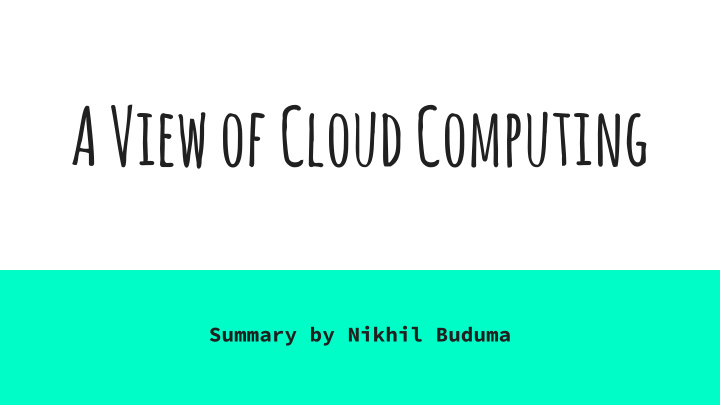



A View of Cloud Computing Summary by Nikhil Buduma
Cloud Computing Definition Refers to: 1) applications delivered over the Internet 2) Hardware and systems software in data centers that provide these services The composite of SaaS (Software as a Service) + utility computing
What Cloud Computing Brings to the Table 1) The appearance of infinite computing resources available on demand 2) Elimination of up-front commitment/cost by users 3) Ability to pay for compute use on a short-term basis and release use as needed 4) Economies of scale due to very large data centers 5) Higher utilization by multiplexing workloads from different organizations 6) Simplify operation and increase utilization via resource virtualization
Classes of Utility Computing Cloud Apps: 1) computation, 2) storage, and 3) communication Offerings exist at various levels of abstraction EC2 - looks like physical hardware and can control nearly the entire software stack AppEngine - targeted exclusively at web applications and appropriate scaling/availability mechanisms Azure - intermediate between AppEngine and EC2 that runs on the .NET stack
Economics of Elasticity Pay-as-you-go model enable overcoming the following scenarios: 1) provisioning static servers for peak load → underutilization (both diurnal and seasonal volatilities) 2) sometimes cannot predict, let alone provision in advance 3) cost associativity for batch analytics
Obstacles
Business Continuity and Service Availability Adoption can sometimes be hindered by wariness of availability (outages, going out of business, regulatory action) Potentially mitigated by using multiple cloud providers
Data Lock-In There’s still low interoperability between platforms due to proprietary storage API’s Attractive to cloud computing providers but users are vulnerable to price increases, security issues, or providers going out of business Standardized API would mitigate problems and also potentially open up hybrid computing approaches
Data Confidentiality and Auditability Trust is a major issue and in the face of HIPAA and other legislation, sometimes a legal requirement Internal security also a significant issue Solutions: Encryption, VLANs, Firewalls
Data Transfer Bottlenecks Data transfer costs are high and add up, which means providers have to think about placement/traffic at every level Solutions: shipping disks and higher b/w switches
Performance Unpredictability VMs share CPUs and main memory surprisingly well, but network and disk I/O is more problematic. HPC need every thread of a program to be running simultaneously and there currently isn’t any good way to do that solutions: flash storage to improve disk I/O, gang scheduling for HPC
Scalable Storage Less clear how to apply cloud principles to persistent storage Open problem: Access the cloud advantage of arbitrarily scaling up and scaling down demand
Bugs in Large-Scale Distributed Systems difficult to debug large distributed applications because buggy conditions aren’t easily reproducible solution: capture new information by leveraging the fact that we’re running on a VM and not physical hardware
Scaling Quickly AWS charges by the hour for the number of instances occupied even if the machine is idle Idle servers also use a lot of power that could otherwise be saved Solution: use machine learning to allow dynamic scaling
Reputation Fate Sharing One customer’s bad behavior can affect others using the same cloud Legal action at a data center (e.g. FBI raid) can hurt other tenants Solution: Offer reputation-guarding services like those for email
Software Licensing Current licenses usually restrict the computers on which the software can run Users pay for annually for software and then a maintenance fee → doesn’t jive well with the pay-as-you-go model Solution: Pay-for-use licenses
Recommend
More recommend